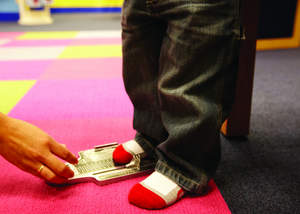MISSION, KS--(Marketwire - Apr 26, 2012) - (Family Features) When it comes to buying shoes for your children, there are so many different styles available; it can sometimes be difficult to figure out which one to choose. The most important thing to keep in mind is that your child needs proper foot support during childhood's critical growth years.
A child's foot can grow up to about the age of 18, and the most important development happens in the first seven years. Here is a quick look at how fast kids' feet grow:
- Under 12 months old, every 2 months.
- 12 months to 2.5 years old, every 3 months.
- 2.5 to 4 years old, every 4 months.
- From 4 to 6 years old, every 6 months.
Shoes that do not fit properly can be uncomfortable and unhealthy. That is why it is important to always measure a child's feet before buying shoes. Every shoe fits differently, so do not buy shoes based solely on the size printed on the shoebox. Make sure your child tries on every shoe and watch them as they walk to make sure they seem comfortable and fit properly.
Shoe Buying Tips
When you find shoes that you like, hold them in your hand and examine them. The American Podiatric Medical Association (APMA), experts in foot health and development, recommends you look for the following features:
Flexibility. Typically, the younger the child, the thinner and more flexible the soles should be. The sole should be easily flexible and be able to bend in your hand without effort. It should bend with your child's toes -- where the ball of the foot will be rather than in the middle of the shoe.
Toe room. While your child is standing, you should be able to press about a half inch, roughly a finger's width, between the longest toe and the front of the shoe. The area of the shoe just below the laces should crease when your baby takes a step.
Materials. The upper part of the shoe should be made of breathable materials such as leather, rather than synthetic materials. The insoles should be cushioned for comfort. Feel around inside the shoe for irregularities in stitching, glue or stapling. Look for a stiff heel cup. Press on both sides of the heel counter. It should not collapse.
To help parents find shoes that fit properly, here are some helpful shoe buying tips:
- Make sure to see a professional trained in fitting shoes for infants, toddlers and young children. For example, Stride Rite's Fit Training Program received the APMA Seal of Acceptance. The seal recognizes products evaluated by a committee of podiatrists that contribute to better foot health.
- Have your child's feet measured every 2 to 3 months until toddler years, then every 3 to 4 months after that.
- Feet are seldom precisely the same size. Always buy for the larger foot.
- Do not buy shoes that need "breaking in." Shoes should be comfortable from the beginning. Observe your child walking around in both shoes for longer than a few minutes. Then, check each foot to make certain there are no irritation marks.
- Make sure the shoe is not too heavy. A heavy shoe can make your child walk irregularly, preventing the development of a normal walking pattern.
- If a child complains of foot pain or discomfort, schedule a check-up with your local podiatrist who specializes in children's foot care.
To learn more, and to find a retail store near you, visit www.striderite.com. To learn more about APMA, visit www.apma.org.
Tips for Buying Kids' Shoes
When it comes to buying shoes for your children, APMA and Stride Rite understand there are many different styles available. Follow their tips to help choose the right shoe for your child's foot health and development:
- Shoes that do not fit properly can aggravate the feet. Always measure a child's feet before buying shoes and fit the shoe to the foot.
- Never hand down footwear. Just because a shoe size fits one child comfortably does not mean it will fit another the same way. In addition, the practice of sharing shoes can spread fungi like athletes foot and nail fungus.
- Watch for signs of irritation. Redness is a sure sign that a shoe is too tight or too loose. If your child always wants to remove one or both of his/her shoes, this may be an unspoken sign that the shoes do not fit properly.
- Examine the heels. When children begin to show in toeing, they may wear through the heels of their shoes much quicker than outgrowing the shoes themselves. Uneven heel wear can indicate a foot problem that should be checked by a podiatrist.
- Shop for shoes later in the day. Feet tend to swell during the day, so take your children shoe shopping when their feet are swollen, to ensure they'll get the proper fit for all day comfort.
About Family Features Editorial Syndicate
This and other food and lifestyle content can be found at www.editors.familyfeatures.com. Family Features is a leading provider of free food and lifestyle content for use in print and online publications. Register with no obligation to access a variety of formatted and unformatted features, accompanying photos, and automatically updating Web content solutions.
Contact Information:
Wendy MacDonald
wmacdonald@familyfeatures.com
1-888-824-3337 ext. 235
http://editors.familyfeatures.com
